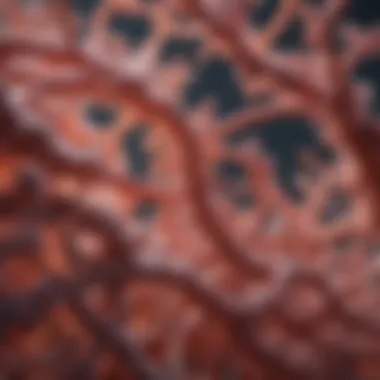Exploring the Biological Significance of ST2 Protein


Intro
ST2 protein, a member of the interleukin-1 receptor family, plays a critical role in various biological processes. Its significance has grown in recent years, especially in understanding different medical conditions such as heart disease and asthma. This article explores the multifaceted nature of ST2, including its structural properties, functional characteristics, and potential therapeutic applications. By dissecting the interactions of ST2 in cellular environments, we aim to provide a comprehensive picture of its relevance in health and disease.
Recent Advances
Latest Discoveries
Recent studies have uncovered the importance of ST2 in inflammatory responses and immune regulation. Researchers have found that elevated levels of soluble ST2 in the blood are associated with poor outcomes in conditions like heart failure and chronic obstructive pulmonary disease. This correlation highlights the potential of ST2 as a biomarker for disease progression.
In clinical trials, drugs targeting ST2 have shown promise in treating various conditions. For example, monoclonal antibodies that inhibit ST2 signaling pathways are being explored for their ability to reduce inflammation and improve cardiac function. Such discoveries are paving the way for new therapeutic strategies centered around ST2.
Technological Innovations
Advancements in technology have facilitated deeper explorations into ST2 biology. High-throughput sequencing and proteomics have allowed for the identification of ST2 interactions at the molecular level, revealing complex signaling networks involved in cellular responses. Moreover, imaging techniques such as flow cytometry have enabled researchers to visualize ST2 expression in different cell types under various conditions.
Methodology
Research Design
Investigating the role of ST2 often requires a multifaceted research design. Clinical studies incorporate both observational and interventional frameworks. Observational studies monitor patients to identify correlations between ST2 levels and clinical outcomes. In contrast, interventional studies assess the effects of specific ST2-targeting therapies on disease progression and patient outcomes.
Data Collection Techniques
Data collection methods are varied but essential for comprehensive analysis. Blood samples taken from patients can be analyzed to measure ST2 levels, employing enzyme-linked immunosorbent assay (ELISA) techniques for precision. Additionally, patient records provide valuable epidemiological data, allowing researchers to correlate ST2 levels with various health conditions.
"The relationship between ST2 levels and disease outcomes underscores the need for targeted research in this space."
Through carefully designed studies and advanced technologies, researchers are continuously uncovering the biological significance of ST2 protein. This narrative seeks to enrich the understanding of ST2’s role both in health and in deteriorating conditions. As our knowledge of ST2 evolves, so too does its potential to shape the future landscape of medical treatment.
Preface to ST2 Protein
Understanding the ST2 protein is critical for appreciating its multifaceted roles in human biology. This article examines its structural, functional, and clinical significance, especially in the context of various medical conditions. The ST2 protein serves as an essential biomarker and therapeutic target, providing insights into numerous diseases ranging from heart failure to autoimmune disorders.
Definition and Overview
ST2 is part of the interleukin-1 receptor family. It exists in two main forms: a membrane-bound and a soluble isoform. The soluble form is the most studied, recognized for its ability to act as a biomarker in various disease environments. This protein plays a significant role in the immune system, modulating inflammatory responses and participating in cellular communication.
In health, ST2 expression is regulated in a delicate balance, contributing to necessary immunological functions. The imbalance, however, can lead to pathological conditions. The presence of elevated levels of soluble ST2 in the bloodstream is associated with adverse outcomes in several diseases, highlighting its potential as a diagnostic and prognostic tool.
Discovery and Historical Context
The journey of ST2 began in the early 1990s when researchers identified it as an interleukin-1 receptor family member. Initial studies focused on its biological properties and interactions within immune cells. Over the years, extensive research has uncovered its significant role not only in immune regulation but also in cardiovascular health and other conditions.
The historical context of ST2 reveals its evolution from a basic scientific discovery to a critical player in clinical applications. It serves as a bridge between immunology and pathology, proving crucial in understanding how immune responses can contribute to disease processes. This contextual background sets the stage for further exploration into ST2's structural characteristics, biological functions, and clinical implications.
Structural Characteristics of ST2
The structural characteristics of ST2 protein are fundamental to understanding its biological roles. The specific configuration of ST2 influences how it interacts with other molecules and elicits biological responses. Structural insights can shed light on its functionality and the potential for therapeutic interventions.
Molecular Composition
The molecular composition of ST2 protein is complex, making it a significant focus of research. ST2 is primarily a member of the interleukin-1 receptor family. It exists in two forms: a membrane-bound form and a soluble form. The differences in these forms are crucial, as they allow ST2 to fulfill diverse functions.
The protein consists of distinct structural motifs that facilitate receptor-ligand interactions. The extracellular domain of ST2 contains a characteristic immunoglobulin-like fold. This domain is responsible for binding to its ligand, interleukin-33. Understanding the amino acid sequence and structural integrity of ST2 can provide insights into its binding capabilities and stability.
Functional Domains
Functional domains within ST2 are critical to its activity. Each domain is designed for specific interactions within the cellular environment. The extracellular domain allows for engagement with ligands, stimulating signaling pathways.
Furthermore, ST2 contains a cytoplasmic domain that is involved in signal transduction. This domain interacts with adaptor proteins that propagate downstream signaling cascades. These include pathways that can modulate immune responses and inflammation. There is a growing interest in exploring these domains for potential therapeutic targeting.
"Mapping the functional domains establishes a basis for understanding ST2's intricate roles in health and disease."


Comparison with Related Proteins
Comparing ST2 to related proteins offers deeper insights into its unique functionalities. ST2 is notably similar to other receptors in the interleukin-1 family, such as IL-1R and IL-18R. These proteins share structural features yet differ in ligand specificity and downstream signaling effects.
For example, while IL-1R primarily interacts with interleukin-1β, ST2's interaction with interleukin-33 initiates distinct cellular responses that play critical roles in allergic inflammation and cardiac remodeling. These comparisons highlight how ST2's structure informs its specific biological functions.
Overall, the detailed structural characteristics of ST2 underscore its importance in both basic and clinical research. Understanding these features can illuminate its pivotal roles in various diseases and guide future therapeutic strategies.
Biological Functions of ST2
The ST2 protein serves various crucial roles in biological processes. Understanding these functions enhances our appreciation of its significance in health and disease. By exploring the immunological, inflammatory, and cardiovascular aspects of ST2, the article sheds light on its multifunctionality. Researchers aim to identify the precise mechanisms through which ST2 influences bodily responses, with therapeutic potential being a key focus.
Role in Immunity
ST2 plays a significant role in modulating immune responses. It acts as a receptor for interleukin-33, which is crucial for T-type immune responses. This interaction promotes the activation and differentiation of T cells, influencing various immune functions. Here are some important points regarding ST2’s role in immunity:
- Modulation of Allergic Responses: Through T differentiation, ST2 is involved in allergic processes, suggesting a connection to conditions like asthma.
- Treg Cell Development: ST2 influences regulatory T cells, which are necessary for maintaining immune tolerance and preventing autoimmunity.
- Cytokine Production: It helps in the release of cytokines, promoting healing and tissue repair, which are essential for a balanced immune response.
Recognition of ST2’s involvement in these processes opens avenues for targeted therapies to treat autoimmune diseases and allergies.
Involvement in Inflammation
ST2’s function extends to the realm of inflammation, where it can either promote or inhibit different inflammatory pathways. The dual role of ST2 in inflammation can be understood through the following points:
- Regulation of Inflammatory Cytokines: The binding of interleukin-33 to ST2 can lead to the downregulation of pro-inflammatory mediators, thus potentially reducing inflammation.
- Tissue Repair Mechanism: In the context of tissue injury, ST2 may facilitate repair mechanisms, highlighting a protective inflammatory response.
- Chronic Inflammatory Diseases: In various chronic conditions, elevated levels of ST2 can indicate ongoing inflammation, leading to its potential use as a biomarker.
Understanding ST2’s contributions to inflammation helps in developing strategies to modulate inflammatory responses therapeutically.
Impact on Cardiovascular Health
Research indicates that ST2 is a significant player in cardiovascular health. It is involved in a range of cardiovascular conditions and presents potential as a biomarker for disease severity.
Key points regarding ST2’s cardiovascular relevance include:
- Heart Failure Marker: Elevated ST2 levels are associated with worse outcomes in heart failure, making it a valuable prognostic indicator.
- Cardiac Remodeling: ST2 signaling has implications for cardiac remodeling processes, emphasizing its role in heart disease progression.
- Response to Heart Injury: In acute cardiac injury, ST2 levels can rise, suggesting its involvement in the heart’s response to stress and damage.
The impact of ST2 on cardiovascular health highlights its potential for monitoring disease progression and therapeutic targeting, underscoring the need for further study in clinical settings.
"ST2 serves as a bridge between immune responses and cardiovascular health, illustrating the intertwined nature of these two biological realms."
Overall, the biological functions of ST2 reveal its multifaceted role in immunity, inflammation, and cardiovascular health. Understanding these functions can lead to innovative therapeutic strategies and deepen insights into disease mechanisms.
ST2 Protein in Disease Pathophysiology
The ST2 protein holds significant relevance in understanding the pathophysiology of various diseases. It serves not only as a marker in cardiovascular health but also is implicated in autoimmune disorders and cancer. Investigating ST2 can provide insights into disease mechanisms, prognostic assessments, and potential therapeutic strategies. The multifaceted role of ST2 protein emphasizes its importance in both acute and chronic conditions, shaping future research avenues.
ST2 and Heart Failure
Heart failure is a complex clinical syndrome characterized by the heart's inability to pump sufficient blood to meet the body's needs. Elevated ST2 levels have emerged as a critical biomarker in this context. Studies show that patients with chronic heart failure often exhibit higher circulating ST2 concentrations. This increase correlates with disease severity and poor outcomes.
The mechanism behind this elevation involves ST2's interaction with interleukin-33 (IL-33). IL-33 is a cytokine involved in cardiac remodeling and inflammation. When heart tissue is stressed or damaged, ST2 acts as a decoy receptor, binding to IL-33 and inhibiting its beneficial effects. This relationship underscores ST2's dual role as an indicator of severity and as a participant in the pathophysiological process.
"Elevated ST2 levels are not just indicative but also contribute to the worsening of heart failure symptoms, creating a feedback loop of deterioration."
ST2 in Autoimmune Disorders
In autoimmune disorders, the immune system mistakenly attacks the body's tissues. Conditions like rheumatoid arthritis and systemic lupus erythematosus show altered ST2 expression. Research indicates that ST2 levels may reflect disease activity. Elevated levels are often associated with increased inflammation and tissue damage.
The presence of ST2 might also suggest the extent of chronic inflammation. ST2's involvement suggests a potential avenue for therapeutic intervention. By targeting ST2, researchers hope to modulate the immune response, potentially reducing the severity of autoimmune reactions.
Understanding ST2's role could be crucial in developing predictive models for disease progression in autoimmune disorders.
Association with Cancer Progression


The role of ST2 is also noteworthy in oncology. Research suggests that ST2 may contribute to cancer biology in various ways. Elevated ST2 levels are linked to poor prognosis in cancers such as breast cancer and lung cancer.
ST2 could be involved in tumorigenesis through its interactions with various cytokines. It may modulate inflammation, which is a critical component in cancer development and progression. Furthermore, monitoring ST2 levels might provide insights into treatment responses, guiding therapeutic approaches.
In summary, the pathological implications of ST2 protein stretch across several medical conditions, particularly heart failure, autoimmune disorders, and cancer. Understanding how ST2 interacts within these contexts not only enriches our knowledge but also opens pathways for future research and therapeutic possibilities.
Clinical Applications of ST2 Measurement
The measurement of ST2 protein has attracted significant attention as a clinical tool, particularly in cardiology and immunology. The capacity of ST2 to serve as a reliable biomarker in various diseases is its foremost asset. This section will examine its applications in clinical settings, highlighting significant elements, advantages, and considerations regarding the use of ST2 measurement.
ST2 as a Biomarker
ST2 protein, a member of the interleukin-1 receptor family, has been identified as a valuable biomarker for several conditions. It is detectable in the serum, making it a non-invasive measure. Research indicates that elevated levels of ST2 are associated with poor prognosis in heart failure patients. This correlation makes it particularly useful in evaluating disease severity and facilitating timely interventions.
Furthermore, ST2 is playing a role beyond cardiovascular health. Studies suggest its elevation in chronic inflammatory conditions. Monitoring ST2 levels can provide crucial information regarding the activity of such diseases, allowing for more tailored treatment approaches.
"The utilization of ST2 as a biomarker has opened new doors in monitoring and managing various health conditions, especially heart diseases."
Predictive Value in Heart Disease
The predictive value of ST2 in heart disease is noteworthy. Elevated ST2 levels correlate with increased cardiovascular risk and mortality. Recent studies have shown that patients with heart failure who have high ST2 concentrations are more likely to experience adverse outcomes, including hospitalization and death.
In clinical practice, assessing ST2 levels can assist healthcare professionals in risk stratification. This means it serves as an important component of patient evaluations, alongside traditional measures like B-type natriuretic peptide (BNP). As a result, ST2 measurement can guide treatment decisions and improve patient management in heart conditions.
Utility in Managing Chronic Conditions
In addition to cardiovascular diseases, ST2 holds promise in managing chronic conditions. Its utility extends to diseases like asthma and systemic lupus erythematosus. Elevated ST2 levels can indicate inflammation and disease activity, making it a useful tool for clinicians.
For instance, in asthma patients, tracking ST2 concentrations might help monitor exacerbations and treatment responses. This can lead to better management strategies and improve overall outcomes. In systemic lupus erythematosus, ST2 measurement may reveal insights into disease flare-ups and help in tailoring therapy accordingly.
The broad application of ST2 across various medical fields indicates its potential. However, clinicians should consider it part of a comprehensive clinical assessment, rather than a stand-alone measure.
In summary, the clinical applications of ST2 measurement illustrate its importance in diagnostics and disease management. The multifaceted role of ST2 as a biomarker highlights its contributions to enhancing patient care. Continued research into its applications will likely expand its role in clinical practice.
Therapeutic Targeting of ST2
The ST2 protein has gained significant attention as a therapeutic target due to its crucial roles in various biological processes and its association with multiple diseases. This aspect of ST2 research offers potential avenues for improving health outcomes, particularly in the context of chronic conditions like heart failure and inflammatory diseases. By understanding the therapeutic implications of ST2, researchers and clinicians can explore interventions aimed at modulating its activity for better patient management.
Current Therapeutic Strategies
Current therapeutic strategies targeting ST2 typically focus on either inhibiting its receptor interactions or modulating its expression. One notable approach involves using anti-ST2 monoclonal antibodies. These antibodies aim to block the binding of IL-33 to the ST2 receptor, thus inhibiting downstream signaling pathways that may lead to harmful inflammatory responses.
Examples of current strategies include:
- Anti-ST2 monoclonal antibodies: These agents are undergoing clinical trials for their effectiveness in treating chronic heart failure. They seek to limit heart damage by reducing inflammatory processes.
- Small Molecule Inhibitors: Small molecules that disrupt ST2 signaling pathways are in development. These may provide a more targeted and potentially less immunogenic approach compared to biological therapies.
The choice of strategy often depends on the specific disease context, highlighting the need for further research into tailored approaches.
Potential Drug Development
As research on ST2 continues to evolve, drug development has also gained momentum. The insights into ST2's biological functions can lead to innovative drugs that could offer health improvement in patients with certain diseases.
Three primary focus areas are:
- Cardiovascular diseases: Given ST2's role in heart pathology, promising drug candidates may emerge that target ST2 to enhance cardiac function and reduce mortality risk.
- Immune modulation: Therapies aimed at re-balancing the immune response through ST2 manipulation can lead to advancements in treatment for autoimmune disorders.
- Cancer therapy: Emerging studies suggest a link between ST2 and cancer progression. Targeting ST2 may present new methods to halt tumor growth or enhance the efficacy of existing cancer treatments.
In sum, continuing exploration of ST2 could lead to valuable drug candidates that address significant unmet medical needs.
Challenges and Opportunities
Despite the promising landscape for ST2-targeted therapies, several challenges persist.
Some notable challenges include:


- Understanding complex interactions: Deciphering how ST2 interacts with other signaling molecules remains a hurdle. This complexity can complicate therapeutic development.
- Safety considerations: Modifying ST2 function could have unintended effects on the immune system, necessitating careful evaluation of safety profiles in trials.
- Personalized medicine: ST2 levels can vary significantly among individuals. Developing personalized approaches based on a patient's unique ST2 profile presents both a challenge and an opportunity for tailored therapies.
However, the opportunities are equally noteworthy:
- Interdisciplinary collaboration: Collaboration among biologists, clinicians, and pharmacologists can stimulate breakthroughs in ST2 research.
- Technological advancements: New technologies, including high-throughput screening for drug discovery and patient stratification methods, can enhance the search for effective ST2-targeted therapies.
Recent Advances in ST2 Research
Research on ST2 protein is evolving rapidly, showcasing its critical role in various biological processes and diseases. Understanding these recent advances is vital for both clinical applications and basic science. Findings from new studies shed light on ST2’s mechanisms of action and its potential as a therapeutic target. Better insight into ST2 can enhance diagnostics and treatment strategies, making it an important subject for students and professionals alike.
Emerging Studies and Findings
Recent literature presents significant advances in understanding ST2. One major area of focus has been its role in cardiovascular health. Studies have shown that elevated levels of soluble ST2 correlate with worse outcomes in heart failure patients. A key study published in the Journal of the American College of Cardiology explored how ST2 can be a prognostic indicator, identifying heart failure patients at higher risk. This finding is essential for developing targeted therapies and guiding clinical decisions.
Moreover, research is now examining ST2's involvement in autoimmune diseases. For example, investigations into rheumatoid arthritis have discovered that ST2 expression levels can provide insights into disease severity. Understanding these correlations helps clinicians manage treatment plans effectively.
In cancer research, recent studies indicate an association between high ST2 levels and tumor aggressiveness in specific cancers. Continued exploration in this field is crucial as it opens up new avenues for treatment strategies based on ST2 targeting.
Integrative Approaches to ST2 Research
Integrative approaches are enhancing our understanding of ST2. Multi-disciplinary collaborations are increasingly common, allowing insights from immunology, cardiology, and oncology to converge. One notable example is the integration of bioinformatics tools to analyze ST2-related databases. This offers researchers the ability to identify patterns and correlations across diverse datasets.
Further, combining genomics and proteomics with traditional research methodologies is deepening insights into ST2’s functionality. By using high-throughput techniques, researchers can assess the effects of ST2 in various cells and tissues more comprehensively.
Collaboration between basic scientists and clinicians is critical. This partnership facilitates the translation of complex research findings into actionable clinical practices. For example, studies focusing on the immunological aspects of ST2 must also consider how these changes affect cardiovascular outcomes. Integrating knowledge across disciplines can lead to innovative therapeutic options and better patient management strategies.
Continued interdisciplinary discussions are essential, as they foster innovation that can translate research discoveries into real-world applications.
Ongoing advances in ST2 research reflect its importance as a biomarker and therapeutic target. The interplay between high-level findings and integrative practices is paving the way for future breakthroughs, advisable for ongoing research efforts.
Future Directions in ST2 Studies
The study of ST2 protein continues to evolve. Future directions in this area focus on addressing current research gaps and enhancing understanding through coordinated efforts across diverse fields. Exploring the potential of ST2 in various biological contexts remains a priority. For researchers and practitioners alike, this area holds significant promise. It offers opportunities to improve disease management and therapeutic strategies.
Research Gaps and Opportunities
Identifying research gaps is essential for advancing the knowledge around ST2 protein. Current findings, while significant, may not provide a full picture of its functions. Some specific areas require more exploration:
- Detailed Mechanisms: Understanding how ST2 interacts at the molecular level with other proteins can reveal pathways important in disease progression.
- Longitudinal Studies: Research should include long-term studies to track changes in ST2 levels and their implications in chronic illnesses.
- Population Diversity: There is a need to study ST2 in various populations to understand the role of genetic and environmental factors.
These gaps present ample opportunity for researchers to contribute to the field. By investigating these areas, the scientific community can better comprehend the biological significance of ST2.
Interdisciplinary Collaboration
Interdisciplinary collaboration is vital for the future of ST2 research. Experts from various fields can provide diverse perspectives that enhance the understanding of ST2's role in health and disease. Collaboration might include:
- Clinical and Laboratory Partnerships: Bringing together clinicians and laboratory scientists can accelerate the application of research findings in real-world scenarios.
- Cross-industry Engagement: Engaging bioinformatics, pharmacology, and molecular biology can drive innovation. This multidisciplinary approach may yield novel therapeutic strategies based on ST2.
- International Research Networks: Forming collaborations across borders allows pooling of resources and expertise. International studies can produce findings that are more broadly applicable.
By fostering such collaborations, the potential for impactful discoveries increases. The future of ST2 studies looks promising if researchers unite their varied expertise to tackle complex biological questions.
End
The conclusion serves an essential role in reinforcing the significance of the ST2 protein in biological systems as discussed throughout this article. Summarizing the core elements allows readers to reflect on the intricate relationships ST2 has with various medical conditions and its potential applications in therapeutic scenarios.
Summary of Key Insights
In our exploration of ST2 protein, we identified several critical insights:
- ST2's Role in Immunity: ST2 is pivotal in modulating immune responses, influencing both inflammation and tissue healing.
- Connection to Heart Failure: Elevated levels of ST2 serve as a biomarker for heart failure, providing prognostic information.
- Involvement in Cancer: Research indicates that ST2 may play a role in cancer progression and metastasis, highlighting its potential for therapeutic intervention.
These findings underscore the multifaceted nature of ST2, illustrating its relevance across a spectrum of diseases.
Implications for Future Research
Future research should focus on several areas to fully capitalize on the therapeutic potential of ST2 protein. Key considerations include:
- Longitudinal Studies: Investigating ST2's behavior over time in various conditions to better understand its role in disease progression.
- Interdisciplinary Collaboration: Encouraging partnerships between immunology, cardiology, and oncology to explore ST2 in a holistic approach.
- Novel Therapeutic Targets: Developing specialized compounds that could modulate ST2 activity, paving the way for innovative treatments.
By addressing these research gaps, the scientific community can enhance our understanding of ST2’s intricate biological role and harness its therapeutic potential more effectively.















